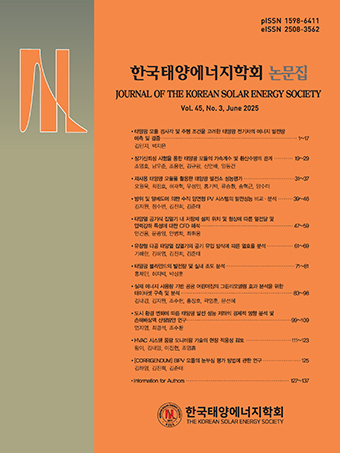Research Article
Abstract
References
Information
Ballif, C., Perret-Aebi, L. E., Lufkin, S., and Rey, E., Integrated Thinking for Photovoltaics in Buildings, Nature Energy, Vol. 3, No. 6, pp. 438-442, 2018, https://doi:10.1038/s41560-018-0176-2.
10.1038/s41560-018-0176-2
Ministry of Trade Industry and Energy, Use and Diffusion of New and Renewable Energy, Act on the Promotion of the Development, 2022. https://www.law.go.kr. last accessed on the 5th December 2022.
Yoo, H.-C. and Park, S.-H., Comparative Analysis of Diverse Typical Weather Data Model for Building Energy Assessment, Journal of the Architectural Institute of Korea Planning & Design, Vol. 30, No. 3, pp. 215-222, 2014, https://doi.org/10.5659/JAIK_PD.2014.30.3.215.
10.5659/JAIK_PD.2014.30.3.215
Passive House Institute Korea, TMY for 70 regions in Korea, 2017. http://www.phiko.kr. last accessed on the 5th December 2022.
Korea Institute of Energy Research, Standard Reference Data, 2020. https://kier-solar.org/. last accessed on the 5th December 2022.
Kočí, J., Kočí, V., Maděra, J., and Černý, R., Effect of Applied Weather Data Sets in Simulation of Building Energy Demands: Comparison of Design Years with Recent Weather Data, Renewable and Sustainable Energy Reviews, Vol. 100, pp. 22-32, 2019, https://doi.org/10.1016/j.rser.2018.10.022.
10.1016/j.rser.2018.10.022
Kim, E.-Y. and Jun, H.-J., A Study on Influence of Type of Weather Data on Results of Building Energy Performance Simulation, Journal of the Architectural Institute of Korea Planning & Design, Vol. 29, No. 3, pp. 317-326, 2013, https://doi.org/10.5659/JAIK_PD.2013.29.3.317.
10.5659/JAIK_PD.2013.29.3.317
Li, D. H. W. and Lam, J. C., Solar Heat Gain Factors and the Implications to Building Designs in Subtropical Regions, Energy and Buildings, Vol. 32, No. 1, pp. 47-55, 2000, https://doi.org/10.1016/S0378-7788(99)00035-3.
10.1016/S0378-7788(99)00035-3
Yoo, H.-C. and Hwang, H.-S., Climate Change and Building Load Variation by Regional Characteristics, Journal of the Architectural Institute of Korea Planning & Design, Vol. 29, No. 3, pp. 345-352, 2013, https://doi.org/10.5659/JAIK_PD.2013.29.3.345.
10.5659/JAIK_PD.2013.29.3.345
Chung, M.-H., The Correlation of Solar Radiation and Atmospheric Elements including Air Pollution, The International Journal of The Korea Institute of Ecological Architecture and Environment, Vol. 19, No. 5, pp. 69-74, 2019, https://doi.org/10.12813/kieae.2019.19.1.069.
10.12813/kieae.2019.19.1.069
Wild, M., Gilgen, H., Roesch, A., Ohmura, A., Long, C. N., Dutton, E. G., Forgan, B., Kallis, A., Russak, V., and Tsvetkov, A., From Dimming to Brightening: Decadal Changes in Solar Radiation at Earth’s Surface, Science, Vol. 308, No. 5723, pp. 847-850, 2005, https://doi.org/10.1126/science.1103215.
10.1126/science.1103215
Li, Y., Wang, Q., Ren, G., Wang, G., and Zhou, Q., Homogenization and Trend Analysis of 1960-2015 in Situ Sea Surface Temperature Observations Along the Coast of China, Acta Oceanologica Sinica, Vol. 40, No. 5, pp. 1-11, 2021, https://doi.org/10.1007/s13131-021-1725-2.
10.1007/s13131-021-1725-2
Wild, M., Wacker, S., Yang, S., and Sanchez-Lorenzo, A., Evidence for Clear-sky Dimming and Brightening in Central Europe, Geophysical Research Letters, Vol. 48, No. 6, 2021, https://doi.org/10.1029/2020GL092216.
10.1029/2020GL092216
Lee, H.-J., Kim, S.-Y., and Yun, C.-Y., Generation of Typical Meteorological Year Data Suitable for Solar Energy Systems and Analysis of Solar Irradiance Data, New & Renewable Energy, Vol. 13, No. 3, pp. 24-33, 2017, https://doi.org/10.7849/ksnre.2017.9.13.3.024.
10.7849/ksnre.2017.9.13.3.024
Kim, S.-Y., Kim, C.-K., Kang, Y.-H., Yun, C.-Y., Jang, G.-S., and Kim, H.-G., Comparative Analysis on the Characteristic of Typical Meteorological Year Applying Principal Component Analysis, Journal of the Korean Solar Energy Society, Vol. 39, No. 3, pp. 67-79, 2019, https://doi.org/10.7836/kses.2019.39.3.067.
10.7836/kses.2019.39.3.067
Jo, E.-H. and Lee, H.-J., Variation of Solar Photovoltaic Power Estimation due to Solar Irradiance Decomposition Models, Journal of the Korean Solar Energy Society, Vol. 39, No. 3, pp. 81-89, 2019, https://doi.org/10.7836/kses.2019.39.3.081.
10.7836/kses.2019.39.3.081
Reindl, D. T., Beckman, W. A., and Duffie, J. A., Diffuse Fraction Correlations, Solar Energy, Vol. 45, No. 1, pp. 1-7, 1990, https://doi.org/10.1016/0038-092X(90)90060-P.
10.1016/0038-092X(90)90060-P
Skartveit, A., Olseth, J. A., and Tuft, M. E., An Hourly Diffuse Fraction Model with Correction for Variability and Surface Albedo, Solar Energy, Vol. 63, No. 3, pp. 173-183, 1998, https://doi.org/10.1016/S0038-092X(98)00067-X.
10.1016/S0038-092X(98)00067-X
Lee, K.-H., Yoo, H.-C., and Levermore, G. J., Quality Control and Estimation Hourly Solar Irradiation on Inclined Surfaces in South Korea, Renewable Energy, Vol. 57, pp. 190-199, 2013, https://doi.org/10.1016/j.renene.2013.01.028.
10.1016/j.renene.2013.01.028
Korea Law Service Center, Enforcement Rule of Korea Meteorological Administration, 2017, https://www.law.go.kr/LSW/admRulLsInfoP.do?admRulSeq=2000000020465. last accessed on the 5th December 2022.
Korea Meteorological Administration, Climatological Normals of Korea (1991-2020), 2021. https://data.kma.go.kr. last accessed on the 5th December 2022.
Perez, R., Ineichen, P., Moore, K., Kmiecik, M., Chain, C., George, R., and Vignola, F., A New Operational Model for Satellite-Derived Irradiances Description and Validation, Solar Energy, Vol. 73, No. 5, pp. 307-317, 2002, https://doi.org/10.1016/S0038-092X(02)00122-6.
10.1016/S0038-092X(02)00122-6
Kim, C.-K., Kim, H.-G., Kang, Y.-H., Yun, C.-Y., Kim, B., and Kim, J.-Y., Solar Resource Potentials and Annual Capacity Factor Based on the Korean Solar Irradiance Datasets Derived by the Satellite Imagery from 1996 to 2019, Remote Sens, Vol. 13, No. 17, 3422, 2021, https://doi.org/10.3390/rs13173422.
10.3390/rs13173422
Choe, M.-H. and Yun, J.-I., On Recent Variations in Solar Radiation and Daily Maximum Temperature in Summer, Korean Journal of Agricultural and Forest Meteorology, Vol. 11, No. 4, pp. 185-191, 2009, https://doi.org/10.5532/KJAFM.2009.11.4.185.
10.5532/KJAFM.2009.11.4.185
Michalak, P., Modelling of Solar Irradiance Incident on Building Envelopes in Polish Climatic Conditions: The Impact on Energy Performance Indicators of Residential Buildings, Energies, Vol. 14, No. 14, 4371, 2021, https://doi.org/10.3390/en14144371.
10.3390/en14144371
- Publisher :Korean Solar Energy Society
- Publisher(Ko) :한국태양에너지학회
- Journal Title :Journal of the Korean Solar Energy Society
- Journal Title(Ko) :한국태양에너지학회 논문집
- Volume : 42
- No :6
- Pages :157-171
- Received Date : 2022-09-29
- Revised Date : 2022-12-16
- Accepted Date : 2022-12-19
- DOI :https://doi.org/10.7836/kses.2022.42.6.157



 Journal of the Korean Solar Energy Society
Journal of the Korean Solar Energy Society








